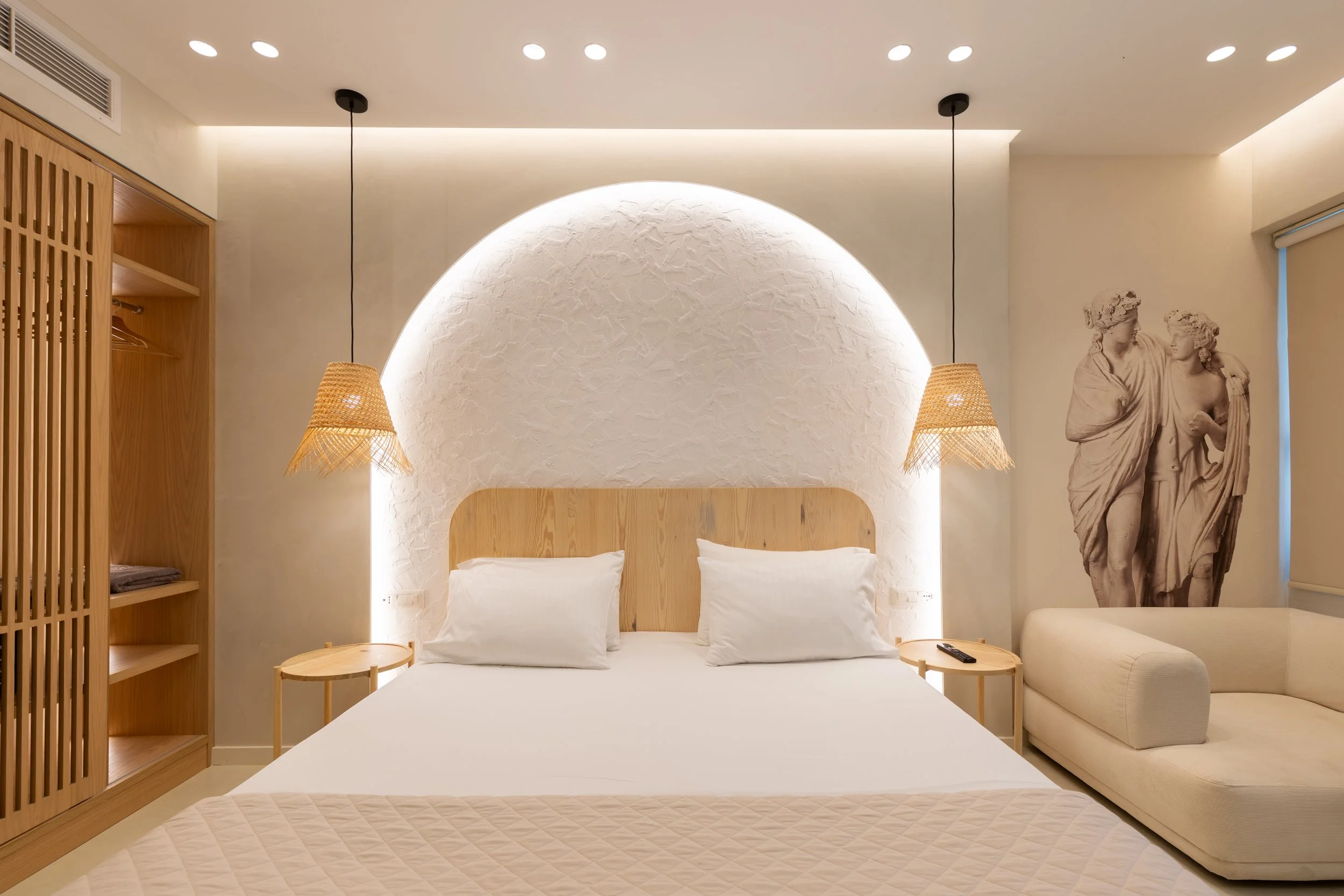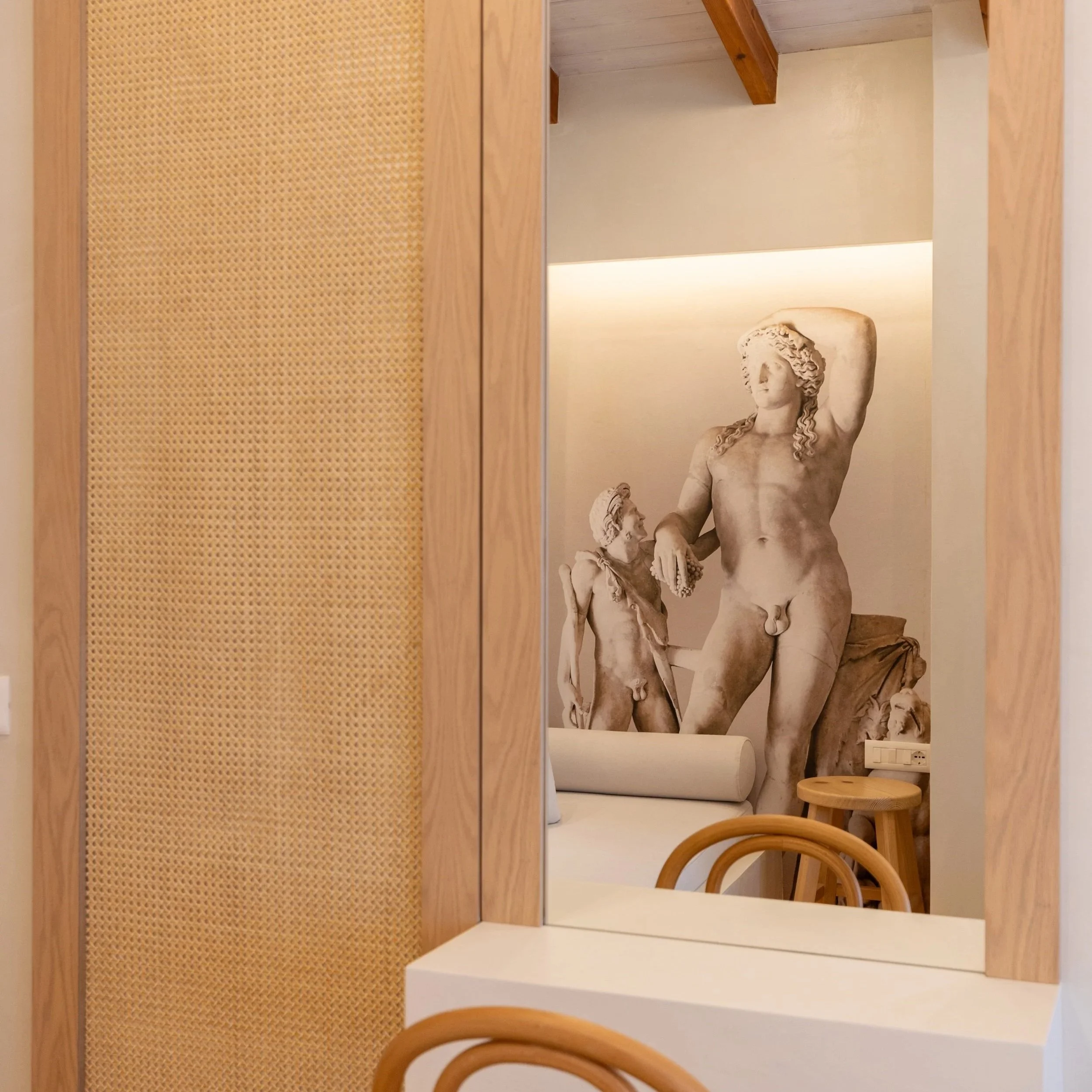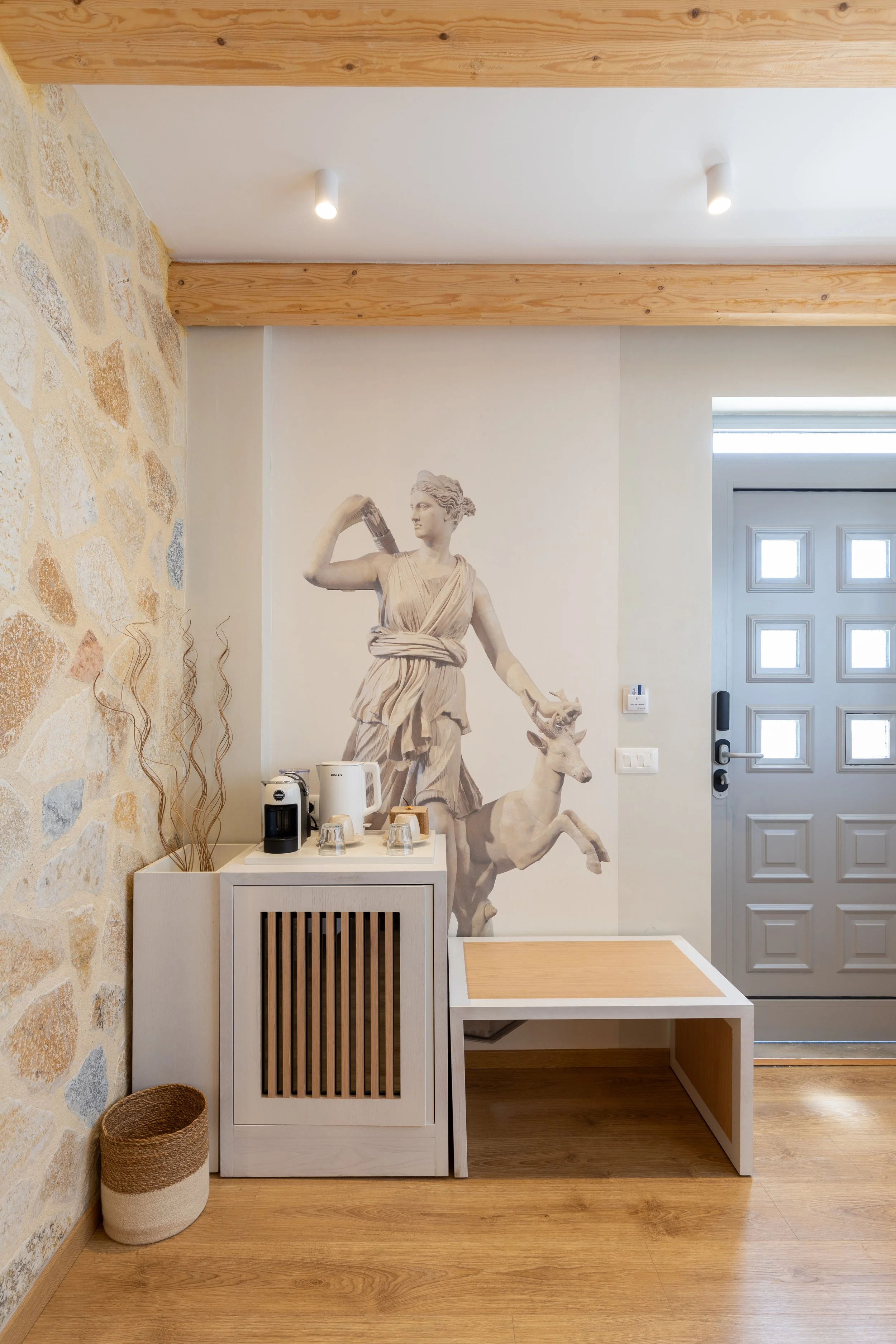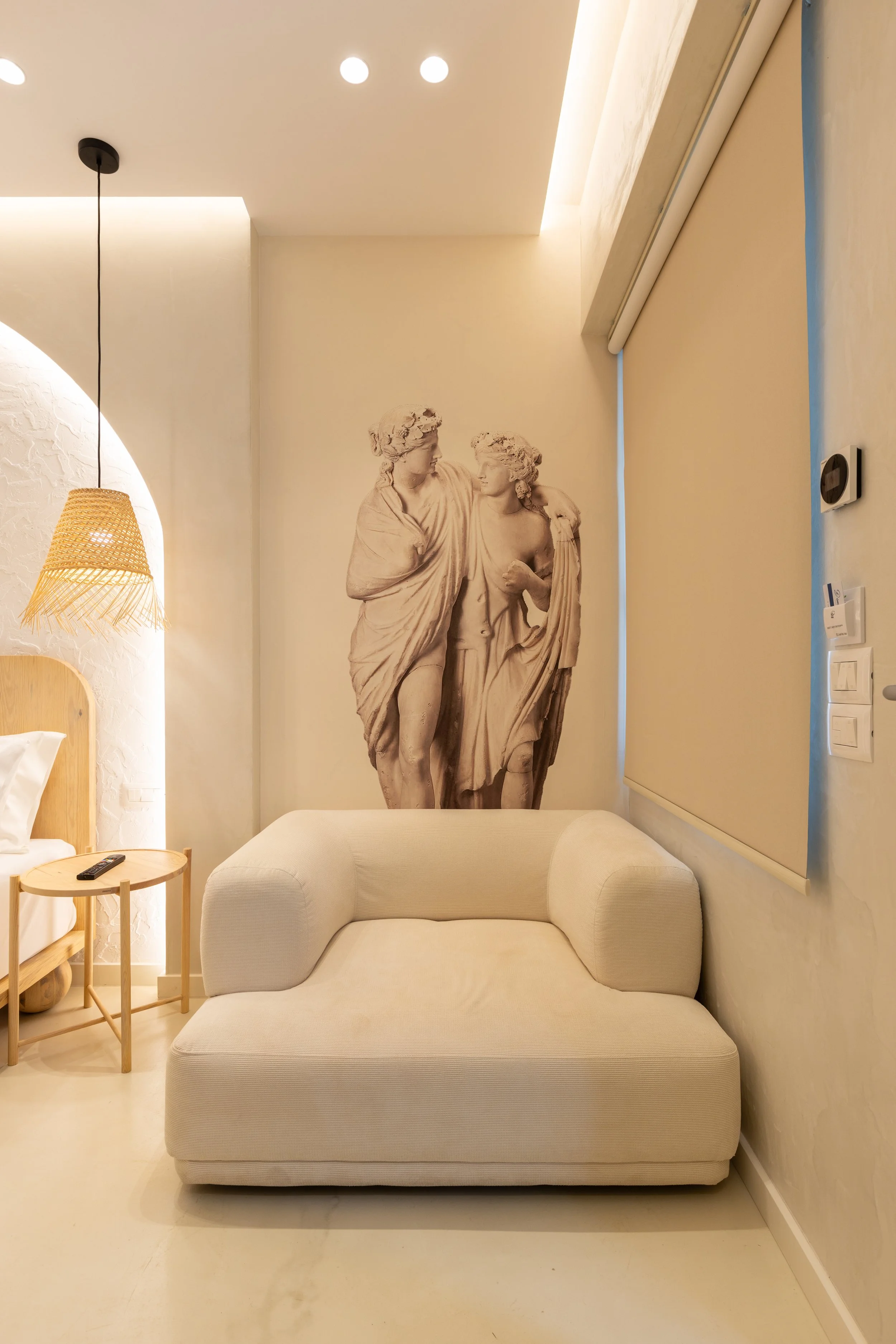Greek Mythology in Contemporary Interiors: When Legend Becomes a Living Space
Table Of Contents
A Dialogue Between the Eternal and Time
The Silent Language of Order: The Three Architectural Orders as Metaphor
Mythological Motifs: When Image Becomes Emotional Language
Greek Key (Meander): The Labyrinth as a Symbol of Life
Busts and Sculptures: The Silent Presence of the Divine
Marble: A Stone That Speaks of Time
Handcrafted Ceramics: The Human Hand in Dialogue with Myth
Color and Light: The Palettes of Olympus
Microcosm and Macrocosm: How Space Becomes a Temple
A Dialogue Between the Eternal and Time
At the heart of every inhabited space lies a story, not just the story of the people who live there but also the story of the images that shape it. When Greek mythology enters contemporary interiors, it does more than bring aesthetic beauty. It brings a narrative. It lives in the carvings of columns, in the waves of the meander motif, in the elegance of a Corinthian capital. It carries a collective memory that speaks of harmony, of the divine, of that delicate tension between the human and the eternal.
The Silent Language of Order: The Three Architectural Orders as Metaphor
In ancient Greek architecture, the three main orders, Doric, Ionic, and Corinthian, were not just structural solutions. They were languages. Each order carried its own character, a vision of the world, a way of being in space.
The Doric order, with its strong, base-less columns, embodied strength and masculinity, the same strength found in the Temple of Zeus, that grounded presence which speaks of earth and the unshakable. When a Doric-inspired column is placed in a modern living room, it is not just a decorative element. It creates a symbolic axis, a gravitational point that brings us back to the foundations, to what is essential.
The Ionic order, with its elegant volutes on the capital, conveys a softer, more feminine sensitivity. It is the order of Athena, of wisdom intertwined with beauty. In a contemporary interior, Ionic details, whether in a stylized mirror frame or the profile of a window, create a kind of visual rhythm that invites the gaze to travel, to explore, to pause on a detail.
The Corinthian order, with its acanthus leaves bursting from the capital, celebrates stylized nature, a beauty that is both organic and crafted. It is the blooming of stone, a poetic paradox reminding us that art is always transformation, a spell that turns material into metaphor.
Mythological Motifs: When Image Becomes Emotional Language
The use of mythological imagery in contemporary interiors is never neutral. Each image carries with it a cultural code, an emotional resonance that works on multiple levels of consciousness.
Greek Key (Meander): The Labyrinth as a Symbol of Life
The Greek Key motif, that broken line that continuously turns into itself, is one of the most powerful symbols in Greek architecture. It originally represented infinity, unity, and the bonds of love and friendship. But on a deeper level, the meander is a labyrinth, a path without a beginning or an end, just like life itself.
When the meander motif is used on a frieze in a room, along the edge of a rug, or as a furniture detail, it brings this sense of a journey into the space. It serves as a quiet reminder that life is a path with turns, returns, and continuations, and all of it forms a harmonious whole.
Busts and Sculptures: The Silent Presence of the Divine
There is something deeply poetic about the presence of a classical bust in a contemporary space. It feels as if time has both stopped and continued at once. The timeless figure of marble exists in the same room where we, the temporary beings, live our daily lives.
As seen in the work of designers like Luke Edward Hall, busts can be both serious and playful. A small bust of Aphrodite next to a modern vase of flowers is not an anachronism. It is a dialogue. It introduces a sense of ritual, a reminder that beauty has always been an object of reverence.
Materializing Myth: Marble, Ceramics, Text
Marble: A Stone That Speaks of Time
In Greek tradition, marble was not just a building material. It was the medium where divinity manifested. The veins in the marble, those dark lines cutting through white surfaces, are like maps of geological time, proof that even stone has a history.
When marble is used today in a bedroom table, a coffee table, or as a wall surface in a kitchen, it is not just an elegant surface. It brings a sense of time that surpasses us, creating a calming psychological effect. In a world where everything changes fast, marble reminds us that some things endure.
Handcrafted Ceramics: The Human Hand in Dialogue with Myth
Greek ceramic tradition, with its vases painted with mythological scenes in astonishing precision, has found a new echo in the contemporary handcrafted ceramics movement. Brands like Liv & Dom Ceramics with their female-figure inspired pieces, or Sophia with their Minotaur labyrinth references, show something essential. Handcrafted objects carry a human quality that industrial production cannot replicate.
When a ceramic object with classical references is placed on a shelf, it is an architectural gesture. It creates a focal point, a small “monument” that organizes both the gaze and meaning around it.
Color and Light: The Palettes of Olympus
Restored Greek temples reveal a forgotten truth. They were not white. They were painted in deep blue, red, and gold. Yet collective memory has made them white, and this whiteness has become an aesthetic code in itself.
Today, classical-inspired interiors often use neutral palettes: off-white, mushroom, taupe. These colors let form and light speak. It is a sophisticated restraint, a way to suggest elegance through subtlety.
There is also another approach, represented by designers like Luke Edward Hall, who use color boldly to remind us that Greece was not only about philosophical Athens. It was also Dionysus, celebration, and vibrant life.
Microcosm and Macrocosm: How Space Becomes a Temple
Designing a room with Greek references is not about creating a museum. It is about understanding that every living space can have a ritual dimension. In Greek thought, the home was not just shelter. It was a microcosm reflecting the macrocosm, the universe.
When a mirror with a frame inspired by a Greek portico is placed in a room, it creates a symbolic portal. A mirror, as an architectural element, is always metaphysical. It doubles space and turns it into something infinite. Combined with classical references, it becomes a portal not just through depth but also through time.
Contemporary Practice: How to Integrate with Sensitivity
The key to successfully using Greek mythological elements in contemporary interiors is balance. It is not about copying a style but about borrowing its language and speaking it with a modern voice.
Some guiding principles:
Mixing periods: A minimalist contemporary chair next to a table with a column base is not a conflict. It is a dialogue.
A touch of irony: As Luke Edward Hall does, a playful approach to mythology, a small bust in bright colors, or a humorous note can make the space feel alive and less like a museum.
Quality over quantity: One strong mythological element, such as a mirror, a column, or a ceramic piece, is better than layering too many motifs that create visual noise.
Light as a structural element: In Greek temples, light was not just functional. It was dramatic. Even today, the way light falls on marble or shadows cast from a column are part of the architectural narrative.
Living Within Memory
Bringing Greek mythology into contemporary interiors is not an act of nostalgia. It is an act of recognition. These visual languages have survived for millennia because they speak to something essential in the human experience. Harmony, proportion, elegance, and strength are not just aesthetic qualities. They are ways of living.
When we enter a space that carries traces of Greek mythology, even through a single detail or motif, we step into a collective memory. We live within a story that existed before us and will continue after us. There is something profoundly comforting in this sense of continuity.
In the end, architecture and interior design are not only about creating functional spaces. They are about creating spaces that hold us, physically and existentially. Greek mythology, with all its symbols and imagery, gives us the language to do exactly that.
